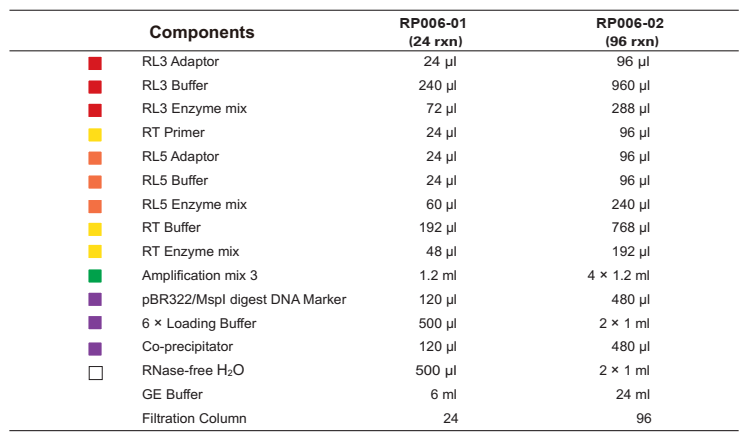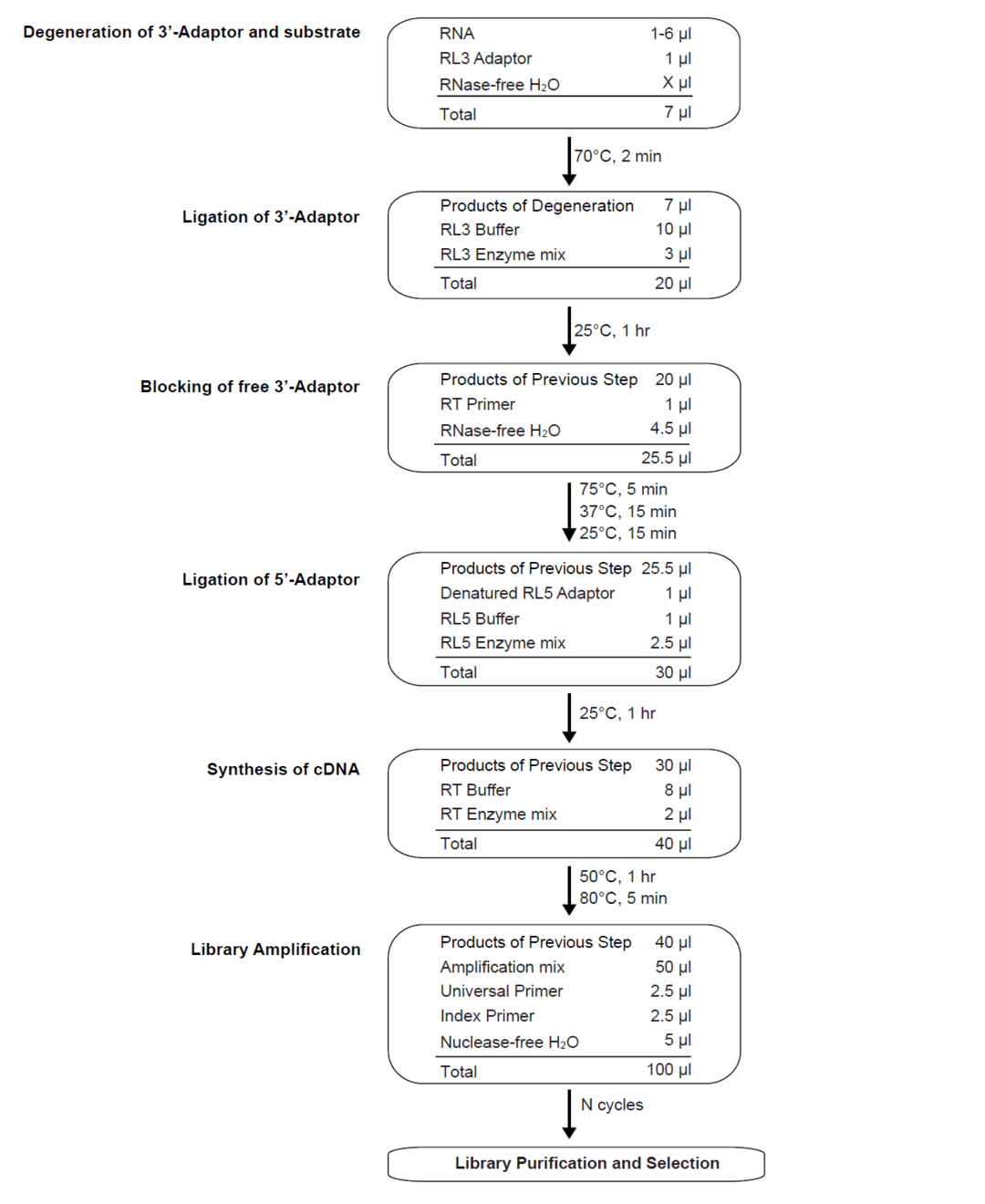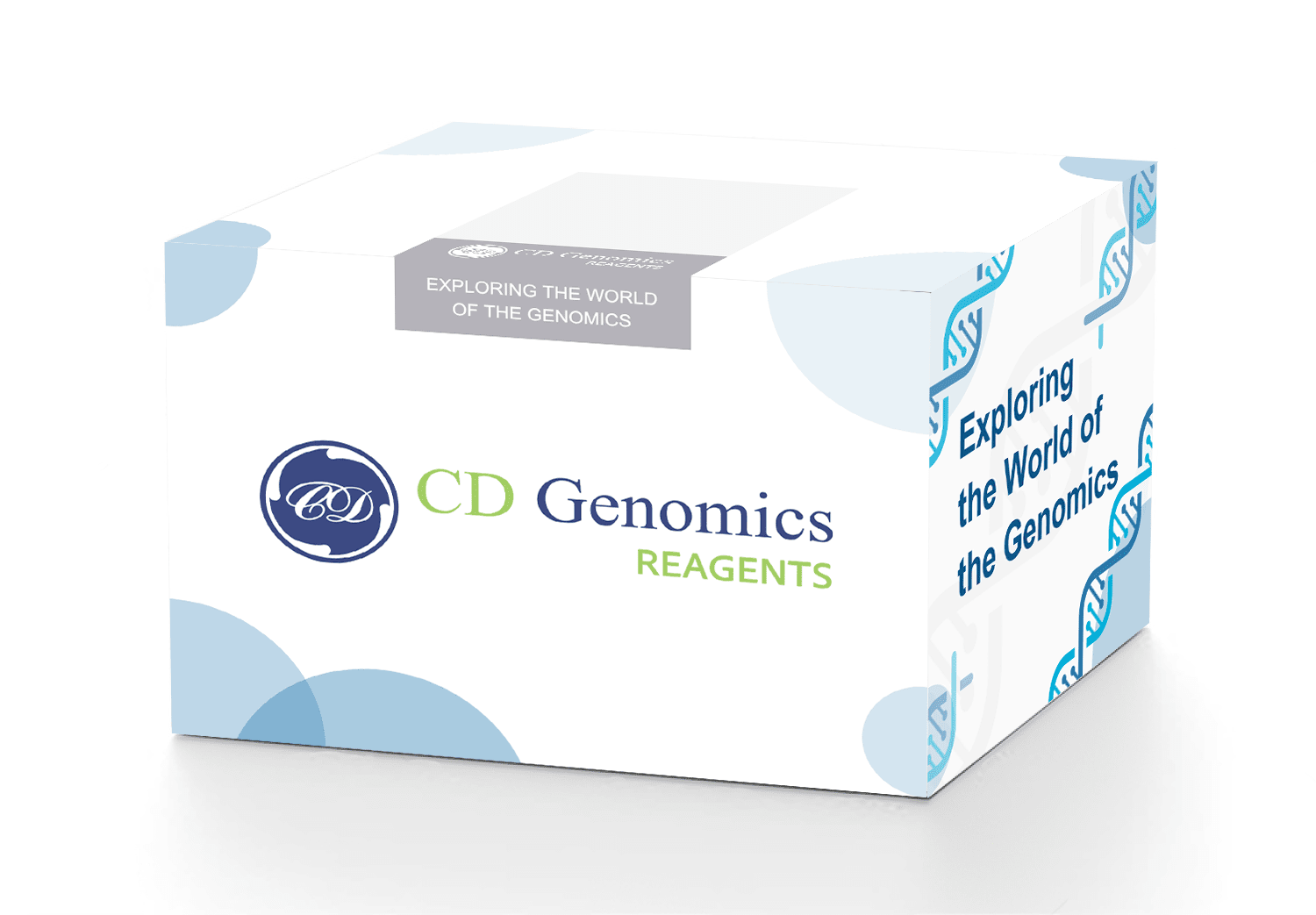The Illumina Small RNA Library Prep Kit facilitates the production of small RNA libraries for Illumina-based next-generation sequencing (NGS) applications. This kit allows you to construct libraries from animals or plants using as little as 100ng of total RNA and as much as 1g of purified short RNA. This kit contains all of the enzymes and buffers required to prepare and select a small RNA library. To make a small RNA library, ligation of universal adapters on the 3' and 5' ends of the tiny RNA, cDNA synthesis, PCR amplification, and size selection employing PAGE gel or magnetic beads are all procedures that can be taken. This kit is preferred for length filtering, small RNA classification, and quantification analysis of known and novel miRNAs.
Storage:
RL5 Adaptor should be stored at -70°C. Filtration Column should be stored at room temperature (15-25°C). Other components should be stored at -20°C
Components:

Specifications:
| Sample amount | 100ng-1µg |
| Features | PAGE gel or magnetic beads can be used in size selection. MicroRNAs (miRNAs) can be efficiently targeted by the special adapters. |
| Application | It is recommended to use this kit for: Length filtering Small RNA classification and quantification Known and novel miRNA analysis |
| Species Category | animals, plants |
| Sample type | total RNA with good purity and integrity or purified small RNA |
| Sequencing Platform | Illumina |
Workflow
 Workflow of CD Small RNA Library Prep Kit for Illumina ®
Workflow of CD Small RNA Library Prep Kit for Illumina ®
Protocol
Ligation of 3’-Adaptor
Take the RL3 Adaptor, RL3 Buffer, and RL3 Enzyme mix out of the kit, thaw and mix thoroughly, spin briefly to bring the sample to the bottom of the tube and put them on ice. All steps below should be on ice.
- Degeneration of 3'-Adaptor and template.
- Incubate in a PCR instrument (pre-heated) at 70°C for 2 min, then immediately chill on ice for 2 min.
- Add RL3 Buffer andRL3 Enzyme mix to the product of previous step.
Blocking of free 3'-Adaptor
Take the RT Primer out of the kit, thaw and mix thoroughly, spin briefly to bring the sample to the bottom of the tube and put them on ice. All steps below should be on ice.
- If the amount of input RNA is > 100 ng, prepare the reaction solution as follows, while if 100 ng of input RNA is used, please dilute the RT Primer with RNase-free H2O at a ratio of 1 : 1 first, and then prepare the reaction solution.
- Mix thoroughly by pipetting up and down for 10-15 times, spin briefly to bring the sample to the bottom of the tube. Put the sample in a PCR instrument and run the program.
Ligation of 5'-Adaptor
Take the RL5 Adaptor, RL5 Buffer, and RL5 Enzyme mix out of the kit, thaw and mix thoroughly, spin briefly to bring the sample to the bottom of the tube and put them on ice. All steps below should be on ice.
- Degeneration of 5'-Adaptor.
- Prepare the reaction solution for the ligation of 5'-Adaptor.
- Mix thoroughly by pipetting up and down for 10-15 times, spin briefly to bring the sample to the bottom of the tube. Put the sample in a PCR instrument and run the program.
Synthesis of cDNA
Take the RT Buffer and RT Enzyme mix out of the kit, thaw and mix thoroughly, spin briefly to bring the sample to the bottom of the tube and put them on ice.
Prepare the reaction solution for reverse transcription. Mix thoroughly by pipetting up and down for 10-15 times, spin briefly to bring the sample to the bottom of the tube. Put the sample in a PCR instrument and run the program.
Library Amplification
Take the Universal Primer, Index Primer, and Amplification mix out of the kit, thaw and mix thoroughly and put them on ice.
Purification of PCR Products
Use the CD DNA Clean Beads for the purification of PCR products.
Library Selection
Select appropriate methods for library selection and purification according to the result of 08-6 Step 9 (Library Quality Control). As shown in Fig. 2, it is recommended to use PAGE Gel for library selection under the following circumstances: too much adaptor dimers at 120 bp, residual primers at 70 - 80 bp, or obvious rRNA at 160 bp and 190 bp. If there is less adaptor primer, primer and rRNA, library selection with magnetic bead is recommended. However, to ensure the ratio of the effective library, library selection with PAGE Gel is also recommended.
Option A: Library selection with a PAGE Gel (6%, non-denatured).
Option B: Library selection with CD DNA Clean Beads.



